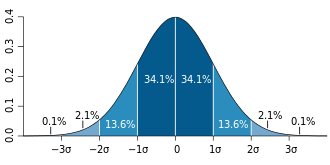Standard error

Standard error (SE) is a statistical term that measures the accuracy with which a sample distribution represents a population by using standard deviation. The standard error is an important concept in the field of statistics and is used in various statistical analyses.
Definition[edit]
The standard error of a statistic (usually the mean) is the standard deviation of its sampling distribution or an estimate of that standard deviation. The term is used in the context of sampling and inferential statistics.
Formula[edit]
The standard error of the mean (SEM) can be calculated using the following formula:
- SE = σ / √n
where:
- σ is the standard deviation of the population.
- n is the sample size.
Interpretation[edit]
The standard error provides an indication of the reliability of the sample mean as an estimate of the population mean. A smaller standard error indicates that the sample mean is a more accurate reflection of the actual population mean. Conversely, a larger standard error suggests that the sample mean is less reliable.
Applications[edit]
Standard error is used in various statistical analyses, including:
- Confidence intervals: The standard error is used to calculate the margin of error for confidence intervals.
- Hypothesis testing: It is used to determine the significance of test results.
- Regression analysis: The standard error of the estimate measures the accuracy of predictions made with a regression line.
Difference from Standard Deviation[edit]
While both standard error and standard deviation measure variability, they are used in different contexts. The standard deviation measures the variability within a single sample, while the standard error measures the variability of the sample mean from the population mean.
Related Concepts[edit]
See Also[edit]
References[edit]
<references group="" responsive="1"></references>
External Links[edit]

This article is a statistics-related stub. You can help WikiMD by expanding it!
Ad. Transform your life with W8MD's Budget GLP-1 injections from $75


W8MD offers a medical weight loss program to lose weight in Philadelphia. Our physician-supervised medical weight loss provides:
- Weight loss injections in NYC (generic and brand names):
- Zepbound / Mounjaro, Wegovy / Ozempic, Saxenda
- Most insurances accepted or discounted self-pay rates. We will obtain insurance prior authorizations if needed.
- Generic GLP1 weight loss injections from $75 for the starting dose.
- Also offer prescription weight loss medications including Phentermine, Qsymia, Diethylpropion, Contrave etc.
NYC weight loss doctor appointmentsNYC weight loss doctor appointments
Start your NYC weight loss journey today at our NYC medical weight loss and Philadelphia medical weight loss clinics.
- Call 718-946-5500 to lose weight in NYC or for medical weight loss in Philadelphia 215-676-2334.
- Tags:NYC medical weight loss, Philadelphia lose weight Zepbound NYC, Budget GLP1 weight loss injections, Wegovy Philadelphia, Wegovy NYC, Philadelphia medical weight loss, Brookly weight loss and Wegovy NYC
|
WikiMD's Wellness Encyclopedia |
| Let Food Be Thy Medicine Medicine Thy Food - Hippocrates |
Medical Disclaimer: WikiMD is not a substitute for professional medical advice. The information on WikiMD is provided as an information resource only, may be incorrect, outdated or misleading, and is not to be used or relied on for any diagnostic or treatment purposes. Please consult your health care provider before making any healthcare decisions or for guidance about a specific medical condition. WikiMD expressly disclaims responsibility, and shall have no liability, for any damages, loss, injury, or liability whatsoever suffered as a result of your reliance on the information contained in this site. By visiting this site you agree to the foregoing terms and conditions, which may from time to time be changed or supplemented by WikiMD. If you do not agree to the foregoing terms and conditions, you should not enter or use this site. See full disclaimer.
Credits:Most images are courtesy of Wikimedia commons, and templates, categories Wikipedia, licensed under CC BY SA or similar.
Translate this page: - East Asian
中文,
日本,
한국어,
South Asian
हिन्दी,
தமிழ்,
తెలుగు,
Urdu,
ಕನ್ನಡ,
Southeast Asian
Indonesian,
Vietnamese,
Thai,
မြန်မာဘာသာ,
বাংলা
European
español,
Deutsch,
français,
Greek,
português do Brasil,
polski,
română,
русский,
Nederlands,
norsk,
svenska,
suomi,
Italian
Middle Eastern & African
عربى,
Turkish,
Persian,
Hebrew,
Afrikaans,
isiZulu,
Kiswahili,
Other
Bulgarian,
Hungarian,
Czech,
Swedish,
മലയാളം,
मराठी,
ਪੰਜਾਬੀ,
ગુજરાતી,
Portuguese,
Ukrainian